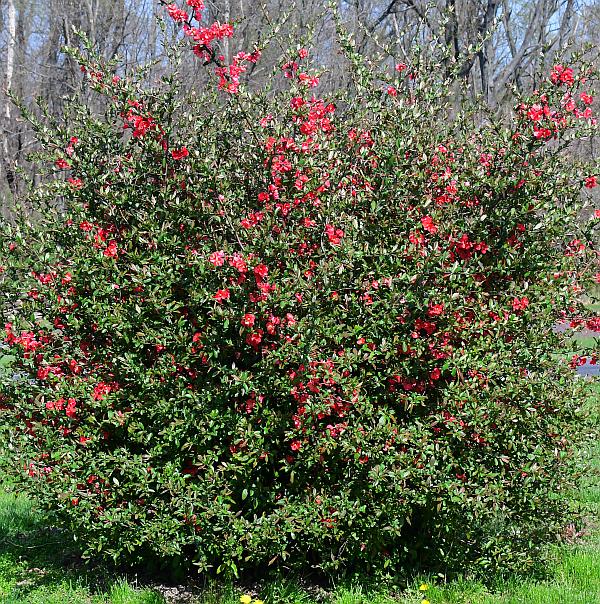Chaenomeles speciosa (Sweet) Nakai
Common Flowering Quince

Introduced
CC = *
CW = 5
MOC = 8
© SRTurner
Chaenomeles speciosa (Sweet) NakaiCommon Flowering Quince | |
 |
Introduced CC = * CW = 5 MOC = 8 |
© SRTurner |
|
Family - Rosaceae Habit - Shrub to 2.5 m, sometimes suckering to form colonies. Stems - Erect to reclining or clambering, multiple from base, glabrous, usually armed with stout, straight thorns. Bark reddish brown to grayish brown, smooth or somewhat roughened.
Leaves - Alternate, or appearing fascicled at the tips of short shoots arising laterally from older branches, folded lengthwise during development, short-petiolate to nearly sessile, the petioles to 5 mm long, glabrous. Stipules present only on vigorously elongating young branches, 5-10 mm long, leafy, kidney-shaped to heart-shaped, the margins finely toothed, shed as the leaves develop. Blades 1.5-10.0 cm long, simple, unlobed, elliptic to elliptic-obovate, tapered at the base, sharply pointed, the margins finely and sharply toothed, the upper surface shiny, glabrous, the undersurface dull gray-green, glabrous or sparsely hairy along the main veins when young.
Inflorescence - Small clusters or single flowers along second-year or older branches, produced before or as the leaves unfold, the stalks very short, glabrous, with a small linear bract, this usually shed before the flower opens.
Flowers - Epigynous, the hypanthium fused to the ovaries, glabrous. Sepals 5, 3-4 mm long, cupped upward or inward, oblong with broadly rounded tips, the margins usually reddish purple and hairy, the inner surface moderately to densely woolly, usually persistent and beaklike at fruiting. Petals 5, 13-22 mm long, free, broadly obovate, clawed, orangish red to red, less commonly pink or white. Stamens numerous, the filaments glabrous, to 1 cm, the anthers 1-2 mm long, yellow. Pistil 1 per flower. Ovary inferior, the tip usually moderately hairy, with 5 locules, each with numerous ovules. Styles 5, fused toward the base, the stigmas 2-lobed, the lobes often somewhat elongate along opposite sides toward the tip of the style. Ovary inferior, 5-locular. Placentation axile. Hypanthium bell-shaped, constricted at base, 8 mm in diameter, 7 mm long, pinkish-rose to greenish-pink, glabrous.
Fruits - Pomes, 30-70 mm long, globose or ovoid, glabrous, yellow to greenish or brownish yellow, with small lighter-colored spots at maturity, with numerous easily exposed seeds embedded in the "core" of leathery carpel wall remains and the fleshy portion, this with small clusters of gritty stone cells. Fruits bitter in flavor, rarely produced in Missouri. Flowering - March - May. Habitat - Cultivated. Origin - Native to Asia. Lookalikes - None. Other info. - This is a popular plant in cultivation in Missouri and elsewhere, and is used as a landscaping shrub and sometimes sculpted into hedges. Escapes from cultivation in Missouri are rare. Photographs taken at the Kansas City Zoo, 4-13-00, and in Columbia, MO., 4-7-04 (DETenaglia); also near Labadie, Franklin County, MO, 4-5-2021 (SRTurner). |